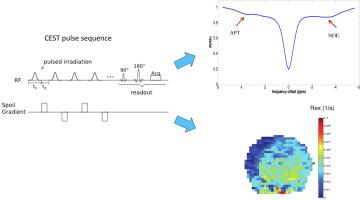当前位置:
X-MOL 学术
›
Prog. Nucl. Magn. Reson. Spectrosc.
›
论文详情
Our official English website, www.x-mol.net, welcomes your feedback! (Note: you will need to create a separate account there.)
Pulse sequences for measuring exchange rates between proton species: from unlocalised NMR spectroscopy to chemical exchange saturation transfer imaging
Progress in Nuclear Magnetic Resonance Spectroscopy ( IF 6.1 ) Pub Date : 2020-10-01 , DOI: 10.1016/j.pnmrs.2020.06.001 Eleni Demetriou , Aaron Kujawa , Xavier Golay
Progress in Nuclear Magnetic Resonance Spectroscopy ( IF 6.1 ) Pub Date : 2020-10-01 , DOI: 10.1016/j.pnmrs.2020.06.001 Eleni Demetriou , Aaron Kujawa , Xavier Golay

|
Within the field of NMR spectroscopy, the study of chemical exchange processes through saturation transfer techniques has a long history. In the context of MRI, chemical exchange techniques have been adapted to increase the sensitivity of imaging to small fractions of exchangeable protons, including the labile protons of amines, amides and hydroxyls. The MR contrast is generated by frequency-selective irradiation of the labile protons, which results in a reduction of the water signal associated with transfer of the labile protons' saturated magnetization to the protons of the surrounding free water. The signal intensity depends on the rate of chemical exchange and the concentration of labile protons as well as on the properties of the irradiation field. This methodology is referred to as CEST (chemical exchange saturation transfer) imaging. Applications of CEST include imaging of molecules with short transverse relaxation times and mapping of physiological parameters such as pH, temperature, buffer concentration and chemical composition due to the dependency of this chemical exchange effect on all these parameters. This article aims to describe these effects both theoretically and experimentally. In depth analysis and mathematical modelling are provided for all pulse sequences designed to date to measure the chemical exchange rate. Importantly, it has become clear that the background signal from semi-solid protons and the presence of the Nuclear Overhauser Effect (NOE), either through direct dipole-dipole mechanisms or through exchange-relayed signals, complicates the analysis of CEST effects. Therefore, advanced methods to suppress these confounding factors have been developed, and these are also reviewed. Finally, the experimental work conducted both in vitro and in vivo is discussed and the progress of CEST imaging towards clinical practice is presented.
中文翻译:

用于测量质子种类之间交换率的脉冲序列:从非定域核磁共振光谱到化学交换饱和转移成像
在核磁共振波谱领域,通过饱和转移技术研究化学交换过程有着悠久的历史。在 MRI 的背景下,化学交换技术已被调整以提高成像对小部分可交换质子的敏感性,包括胺、酰胺和羟基的不稳定质子。MR 对比是由不稳定质子的频率选择性辐射产生的,这导致与不稳定质子的饱和磁化转移到周围自由水的质子相关的水信号减少。信号强度取决于化学交换速率和不稳定质子的浓度以及辐照场的性质。这种方法被称为 CEST(化学交换饱和转移)成像。CEST 的应用包括对具有较短横向弛豫时间的分子进行成像,以及绘制生理参数,例如 pH、温度、缓冲液浓度和化学成分,因为这种化学交换效应依赖于所有这些参数。本文旨在从理论上和实验上描述这些影响。为迄今为止设计用于测量化学交换率的所有脉冲序列提供了深入分析和数学建模。重要的是,很明显,来自半固体质子的背景信号和核奥弗豪泽效应 (NOE) 的存在,无论是通过直接偶极-偶极机制还是通过交换中继信号,都使 CEST 效应的分析变得复杂。因此,开发了抑制这些混杂因素的先进方法,这些也被审查。最后,讨论了体外和体内进行的实验工作,并介绍了 CEST 成像在临床实践中的进展。
更新日期:2020-10-01
中文翻译:

用于测量质子种类之间交换率的脉冲序列:从非定域核磁共振光谱到化学交换饱和转移成像
在核磁共振波谱领域,通过饱和转移技术研究化学交换过程有着悠久的历史。在 MRI 的背景下,化学交换技术已被调整以提高成像对小部分可交换质子的敏感性,包括胺、酰胺和羟基的不稳定质子。MR 对比是由不稳定质子的频率选择性辐射产生的,这导致与不稳定质子的饱和磁化转移到周围自由水的质子相关的水信号减少。信号强度取决于化学交换速率和不稳定质子的浓度以及辐照场的性质。这种方法被称为 CEST(化学交换饱和转移)成像。CEST 的应用包括对具有较短横向弛豫时间的分子进行成像,以及绘制生理参数,例如 pH、温度、缓冲液浓度和化学成分,因为这种化学交换效应依赖于所有这些参数。本文旨在从理论上和实验上描述这些影响。为迄今为止设计用于测量化学交换率的所有脉冲序列提供了深入分析和数学建模。重要的是,很明显,来自半固体质子的背景信号和核奥弗豪泽效应 (NOE) 的存在,无论是通过直接偶极-偶极机制还是通过交换中继信号,都使 CEST 效应的分析变得复杂。因此,开发了抑制这些混杂因素的先进方法,这些也被审查。最后,讨论了体外和体内进行的实验工作,并介绍了 CEST 成像在临床实践中的进展。



























 京公网安备 11010802027423号
京公网安备 11010802027423号